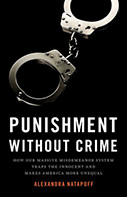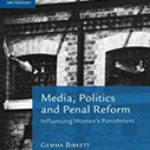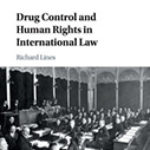Punishment Without Crime: How Our Massive Misdemeanor System Traps the Innocent and Makes America More Unequal

Author: Alexandra Natapoff
Publisher: New York: Basic Books, 2018. 352p.
Reviewer: Peter Grabosky | March 2019
In this book, Alexandra Natapoff, former federal public defender and currently Professor of Law at the University of California, Irvine, consistently avoids using the word “justice.” She refers instead to the “criminal system” or “criminal process.” One soon learns why: hers is a scathing indictment of the misdemeanor process in US courts.
The maxim “de minimis non curat lex” (the law does not concern itself with trifles) does not apply to lower criminal courts in the United States. Misdemeanor arrests number in excess of thirteen million per year. Ironically, their sequelae are often more odious than the conduct that gave rise to the charges in question. Natapoff’s book begins with a long parade of horribles, not in the rhetorical sense of dreadful predictions, but rather by documenting concrete examples of shameful real-world behavior on the part of legislators, police, prosecutors and judges.
A great deal of conduct defined as criminal may be less than desirable in the eyes of sensitive members of the public, but remains fundamentally harmless. These include: begging; a lack of civility when dealing with police officers (“contempt of cop”); some forms of trespassing; or merely standing on a street corner at an inopportune time. Other criminal acts may entail risks, but not inherent harm. Think jaywalking, or failure to use a seatbelt while driving. One should also note that times change. As Cole Porter reminded us, “In olden days, a glimpse of stocking was looked on as something shocking.” Today in the United States, a great deal of activity once defined as criminal is now quite legal. Much consensual sexual activity between adults in private, and the sale of alcoholic beverages, are but two examples. But these withdrawals by the state have been eclipsed and overcompensated by an accretion of legislative and administrative controls that have become Kafkaesque. The numbers of individuals swept up into the misdemeanor system, and the relatively trivial nature of their alleged transgressions, are staggering.
So too are the ways in which such cases are processed. The organization and functioning of lower criminal courts has often been described by the term “assembly line.” The mass production of criminals is just that. Prosecutors refer to their role in misdemeanor courts as “Meet ‘em, greet ‘em, and plead ‘em.” But the disgrace does not end there. Fundamental constitutional rights are routinely ignored, if not consciously flouted, and thousands of innocent people are convicted each year.
Penalties imposed on offenders are often grossly disproportionate to their alleged wrongdoing. One woman was detained in jail for a year over a $72 theft. Moreover, charges and punishments compound and cascade. Failure to pay a parking fine, whether intentionally or through negligence, can result in criminal charges, which in turn can lead to the suspension of one’s driver’s license or even incarceration. The Council of State Governments has identified nearly 9,000 statutory consequences that may follow a misdemeanor conviction. So it is that single mothers are sent to jail for unpaid traffic fines. This conjures up images of the debtors’ prisons of yesteryear. In some cases, offenders are billed for a portion of the costs of their incarceration. A significant proportion of the cost of criminal proceedings are thus shifted to the poor.
But the burdens do not end there. Regardless of whether the accused is eventually incarcerated, convictions alone can result in the termination of one’s employment and can jeopardize the prospect of future work. It can lead to disqualification for public housing and income support. An individual who is economically marginalized to begin with can ill-afford such additional burdens.
The misdemeanor process is racially biased and regressively redistributive. Rigorous prosecution of petty offences by African-Americans was a mainstay of criminal policy in the US following the Civil War. It is perhaps not surprising that Dr Martin Luther King, Jr. was jailed on 30 separate occasions. The legacy of these practices is broadly visible today. While prevalence of drug use is roughly comparable across major racial categories, arrest rates for African-American drug offenders are significantly higher. The same applies to gambling arrests. During one five-year period, police in Baltimore arrested 657 individuals for playing cards or gambling. All but five were African-American. Most of us are familiar with the term “Driving while Black,” which refers to the discriminatory exercise of police discretion that results in an over-representation of African-Americans in the arms of the law. The more clinical term is “racial profiling.”
It will come as no surprise that the vast majority of misdemeanor defendants are poor. In general, the indiscretions of the wealthy tend to be overlooked by police. Affluent suspects are often able to mobilize vocabularies of contrition or extenuation that reduce the likelihood that police will proceed with an arrest. Should they do so, they will invite the engagement of defense counsel, whose involvement is often sufficient to inhibit further action. One need not strain one’s imagination to sense how the legitimacy of the criminal process, and indeed, of the state, is perceived by the poor and by citizens of color.
Reform of the misdemeanor system is impeded by organizational inertia, by cost, and by ideology. It is, moreover, laden with perverse incentives. Legislators, with an eye to the next election, reflexively enact additional prohibitions in response to citizen demands, reasoned or otherwise. Police may be required to meet departmental arrest quotas, creating a situation where quantity trumps quality. As a result, some charges are entirely fabricated. Defendants, usually unrepresented, are faced with a choice: contest the charges and go to jail until a hearing can be held, or plead guilty and receive a non-custodial sentence. Even the innocent defendant will find the offer difficult to refuse.
The suffocating logic of managerialism privileges process over justice. The staggering caseloads that result from indiscriminate policing lead prosecutors and judges, themselves elected officials, to depend on guilty pleas. Clearing cases becomes more important than adherence to the rule of law.
The misdemeanor system is also fraught with commercialism. This is not entirely new: decades ago it was observed that a defendant’s custody or liberty prior to disposition depended upon a decision by a bail bondsman, a commercial actor whose concern was entirely financial. Natapoff suggests that today, the expression “cash-register justice” remains all too appropriate. This is taken to absurd extremes, as misdemeanor courts have become a forest of Catch 22 situations. Defendants have been billed for court time. Indigent defendants have been required to pay for the services of a public defender. We learn that one prosecutor’s office in Florida charges defendants $50 to plead guilty.
Conflicts of interest abound. In one jurisdiction, judges impose fines, the proceeds of which flow to a fund set aside to reimburse judicial expenses. The move to privatize probation services has resulted in some private probation companies billing their offender/clients for supervisory services. These same companies report back to the court, and as such are in a position to request the court to extend the term of probation. Some probationers, left unemployable by their criminal record, resort to theft in order to pay their probation fees.
Despite its horrendous revelations, the book’s concluding chapters provide some grounds for encouragement. Its first prescription is to limit the scope of the criminal law, but to do so in a responsible manner, recognizing that public attitudes can and do change, and may at times require selective intensification of the law’s reach. One notes that drink driving, intimate partner violence, and the possession of erotic images of children, once regarded as relatively minor matters, are now considered to be much more serious.
But there is ample precedent and contemporary opportunity to reduce the number of petty crimes. History is rich with examples. Thanks to the US Supreme Court, married couples can access contraceptives with impunity. Such a transaction previously constituted a misdemeanor in Connecticut and elsewhere (Griswold v. Connecticut (1965). Vagrancy is no longer a criminal offence (Papachristou v. City of Jacksonville (1972). Public drunkenness has come to be regarded as a health issue and less a criminal matter. More recently, a growing number of US states have legalized marijuana for medical and/or recreational use.
It is an unfortunate truth that police are left to confront the problems created by the shortcomings of other agencies of the state. Too many jurisdictions leave homelessness and public drug use to the police when such problems might be more effectively dealt with by welfare and mental health agencies. For the time being, Natapoff contends that police should constrain their infatuation with broken windows policing, and “stop and frisk” practices. Needless to say, they should avoid the use of arrest quotas, or the use of arrest totals as performance indicators.
Some prosecutors have begun to exercise a degree of quality control with regard to the cases presented to them by police, dismissing cases peremptorily. Others are more pro-active. I was once told by a prosecutor that he advised police in his jurisdiction not to bring him any marijuana cases unless they involved dealing outside a school yard. In recent times, The Bronx DA has refused most if not all trespass cases.
The courts have provided a useful avenue for citizens to address some of the more egregious defects of the misdemeanor process. The NAACP and the ACLU have sued the Baltimore Police over their racially discriminatory mass arrest practices. Until recently, the local jail in Houston, Texas received nearly 25,000 arrestees annually. In 2017, its bail practices were declared unconstitutional by a US District Court Judge, and thousands of prisoners were released.
It should also be obvious that courts should be funded from general revenue, not from fines and from the various fees and charges euphemistically called “Legal Financial Obligations.”
One of the challenges faced by Natapoff in her research related to the availability of data. At a time when the US government spends billions of dollars monitoring the communications of its citizens, basic statistical information on the operation of misdemeanor courts does not exist. It should be borne in mind that these courts wield the power to deprive a citizen of his or her liberty. To do so more or less invisibly is shameful. Of interest to researchers is Natapoff’s observation that the decentralized structure of the misdemeanor system in the US lends itself to meaningful policy research, an opportunity that has yet to be fully seized.
The aim of this book is to show the extent to which the machinery of the misdemeanor criminal process in the United States is broken, and to suggest how it can be repaired. The author has achieved this goal admirably, and in the grimmest detail. The book is an appalling indictment of a country accustomed to presenting itself as the leader of the free world, and a champion of the rule of law. In many cases, simple legalization, decriminalization, or responsible policing will contribute to a reduction in the millions of cases brought annually before lower criminal courts. Re- engineering of the process itself will result in further remediation. But the reader is left with a lingering appetite for something more. What are perceived by some citizens as minor breaches of public decorum, and therefore unworthy of police attention, others still view as frightening or repulsive, demanding of some solution. Given the inadequacy of the criminal process as an institution of social control, how should such practices as spitting, jaywalking, excessive noise, unbridled profanity, begging, public urination, and harassment of women be discouraged ? Perhaps this calls for another book.
Peter Grabosky, Professor Emeritus, Australian National University


